John XXIII’s radio “message” of 20 August 1959 to the Marian Congregation sodalities gathered in Novara is, at first glance, a pious exhortation: it greets Archbishop Józef Gawlina and the assembled clergy and laity; it praises Marian sodalities as “vanguards” of apostolic action; it urges consecration to Our Lady, imitation of her virtues, and generous lay apostolate adapted to “the conditions of our times.” It repeatedly extols Mary as the path to Christ, citing Bernard of Clairvaux, and presents Marian sodalities as a disciplined “pious militia” within the Church, ordered to spreading devotion, defending “holy laws,” and engaging in charitable works in modern society.
Yet beneath the devout surface, this address subtly relocates Marian devotion and lay “apostolate” into the programmatic framework of the incipient conciliar revolution, preparing souls for naturalistic activism, laicized ecclesiology, and submission to a new orientation of the “Church,” in which Our Lady is instrumentalized as a decorative emblem for a coming apostasy rather than as the implacable defender of the integral Catholic faith.










